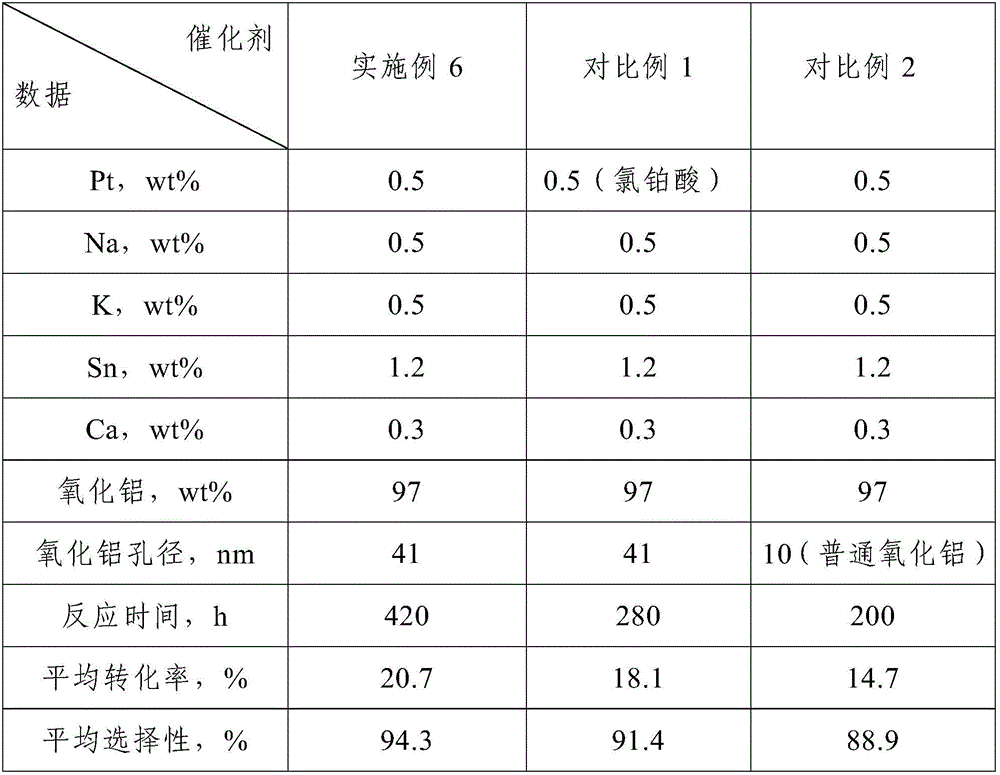Platinum macroporous aluminum oxide catalyst for preparing propylene through propane dehydrogenation
A macroporous alumina and propane dehydrogenation technology, applied in physical/chemical process catalysts, metal/metal oxide/metal hydroxide catalysts, catalyst activation/preparation, etc., can solve the limitation of chromium catalyst use and short catalyst life , selectivity is not high, to achieve small distribution, reduce the rate of carbon deposition or coking reaction, the effect of fast diffusion rate
- Summary
- Abstract
- Description
- Claims
- Application Information
AI Technical Summary
Problems solved by technology
Method used
Image
Examples
Embodiment 1
[0018] The platinum macroporous alumina catalyst for propane dehydrogenation to propylene provided in this example uses macroporous alumina with a diameter of 1.3 mm to 1.4 mm and a pore diameter of 25 nm as the carrier, Pt as the active component, and Na as the first catalyst. As the auxiliary agent, the metal M is used as the second auxiliary agent, and the M is K, Ca and Sn. The mass percentage of each component in the catalyst is shown in Table 1. The catalyst is prepared by a spraying-roasting method, and the specific process of the spraying-roasting method is as follows: 0.68g dinitrosodiammine platinum, 3.81g sodium chloride, 0.76g potassium chloride, 1.1g tin chloride Add 3.05g of calcium chloride and 3.05g of calcium chloride into hot water at a temperature of 35°C, stir evenly, spray it on the macroporous alumina, then place it in a muffle furnace, and roast it at a temperature of 700°C for 4 hours to obtain the depropane Platinum macroporous alumina catalyst for hyd...
Embodiment 2
[0020] The platinum macroporous alumina catalyst for propane dehydrogenation to propylene provided in this example uses macroporous alumina with a diameter of 1.3 mm to 1.4 mm and a pore diameter of 21 nm as the carrier, Pt as the active component, and Na as the first catalyst. As the auxiliary agent, the metal M is used as the second auxiliary agent, and the M is K, Ca and Sn. The mass percentage of each component in the catalyst is shown in Table 1. The catalyst is prepared by a spraying-roasting method, and the specific process of the spraying-roasting method is as follows: 0.68g dinitrosodiammine platinum, 1.78g sodium chloride, 1.91g potassium chloride, 1.76g tin chloride Add 0.56g calcium chloride and 0.56g calcium chloride into hot water at a temperature of 50°C, stir evenly, spray it on the macroporous alumina, then place it in a muffle furnace, and roast it at a temperature of 600°C for 5 hours to obtain the depropane Platinum macroporous alumina catalyst for hydrogen...
Embodiment 3
[0022] The platinum macroporous alumina catalyst for propane dehydrogenation to propylene provided in this example uses macroporous alumina with a diameter of 1.3 mm to 1.4 mm and a pore diameter of 15 nm as the carrier, Pt as the active component, and Na as the first catalyst. As the auxiliary agent, the metal M is used as the second auxiliary agent, and the M is K, Ca and Sn. The mass percentage of each component in the catalyst is shown in Table 1. The catalyst is prepared by a spraying-roasting method, and the specific process of the spraying-roasting method is as follows: 0.68g dinitrosodiammine platinum, 2.29g sodium chloride, 0.76g potassium chloride, 2.63g tin chloride and 1.11g of calcium chloride were added to hot water at a temperature of 60°C, stirred evenly, and then sprayed onto macroporous alumina, then placed in a muffle furnace, and roasted at a temperature of 400°C for 8 hours to obtain depropane Platinum macroporous alumina catalyst for hydrogen to propylene...
PUM
| Property | Measurement | Unit |
|---|---|---|
| diameter | aaaaa | aaaaa |
| pore size | aaaaa | aaaaa |
| pore size | aaaaa | aaaaa |
Abstract
Description
Claims
Application Information
 Login to View More
Login to View More - R&D
- Intellectual Property
- Life Sciences
- Materials
- Tech Scout
- Unparalleled Data Quality
- Higher Quality Content
- 60% Fewer Hallucinations
Browse by: Latest US Patents, China's latest patents, Technical Efficacy Thesaurus, Application Domain, Technology Topic, Popular Technical Reports.
© 2025 PatSnap. All rights reserved.Legal|Privacy policy|Modern Slavery Act Transparency Statement|Sitemap|About US| Contact US: help@patsnap.com


